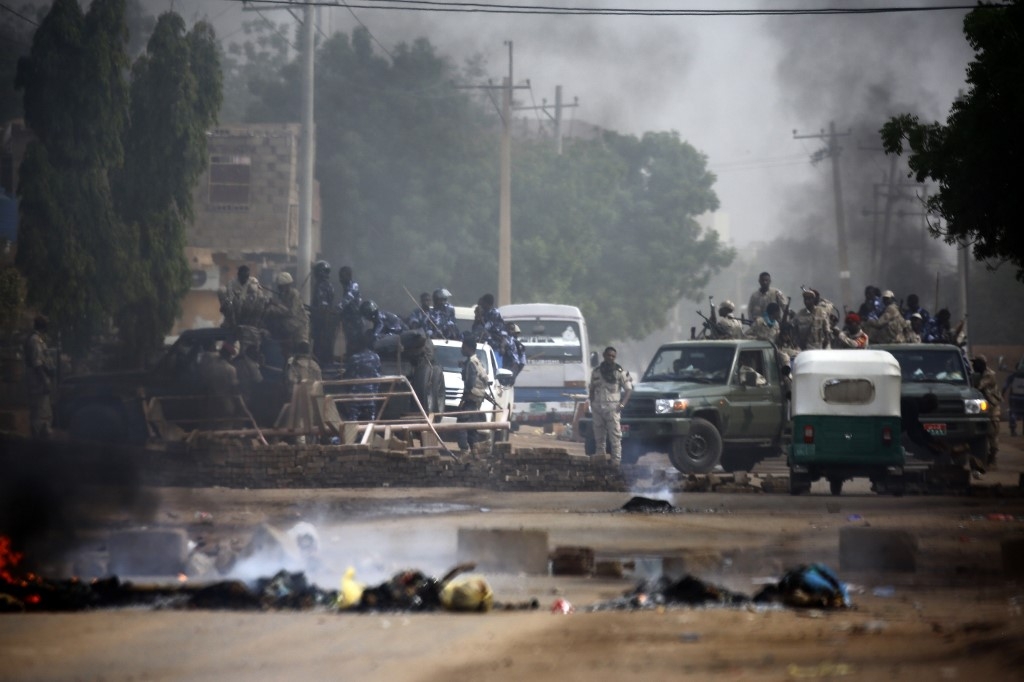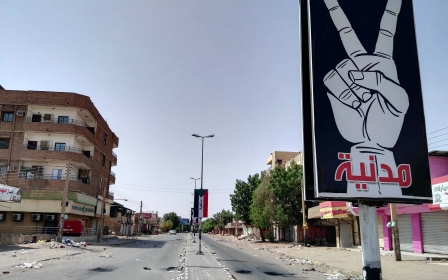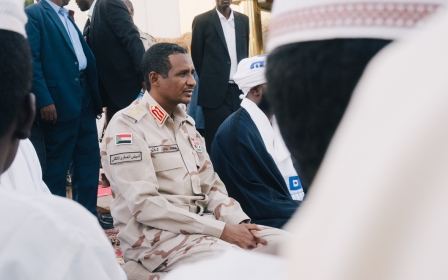A siege, then a storm: How Sudan's sit-in was cleared

Abandoned barricades, smouldering tents and roaming groups of uniformed troops are all that remain at the sprawling site that until this morning was occupied by thousands of hopeful Sudanese protesters.
After almost two months, the sit-in was dispersed on Monday morning under a hail of bullets, as fighters set fire to tents and beat whoever challenged them.
A doctors' committee linked to the opposition said at least 35 people were killed in the violence, Reuters reported. At least 116 people were also wounded, the committee said.
Fears had been growing over the past week, as three people were killed just outside the sit-in. By Sunday night troops were massing on the peripheries of the protest, Middle East Eye witnessed.
Stay informed with MEE's newsletters
Sign up to get the latest alerts, insights and analysis, starting with Turkey Unpacked
Increasing numbers of troops in various uniforms - including the notorious desert camouflage of the Rapid Support Forces (RSF) paramilitary that have been blamed for other attacks on the protesters - arrived in pickup trucks throughout the night.
At night, the power was cut in the area. A few hours later, the bullets started.
Footage shared on social media shows the moment at 5am when protesters facing down the lines of troops were forced to abruptly turn around and flee the bullets crackling through the air.
"During the month of Ramadan," protesters shouted in disbelief on the video, as the thick crowds scattered, leaving the forces to push through the barricades protesters had initially built to halt such an attack.
"We saw the RSF coming and they began throwing stun grenades, then they used tear gas and raided the barricades," said Gamal Adam, a protester who had been manning barricades leading into the sit-in.
"They entered and started firing live bullets into the air and they targeted anyone who resisted and burned the tents to the ground."
Another protester, Ahmed Abdul Azim, said the soldiers used live bullets and flogged protesters with whips.
Footage apparently shot by an RSF soldier shows the paramilitary's troops destroying parts of the sit-in
Troops stormed the sit-in from several sides and after half an hour controlled all of the barricades at the site, entering with their military vehicles.
The protester-aligned Sudanese Doctors’ Committee said at least 116 people have been injured but the number of both the dead and the wounded is rising.
It also cited eyewitnesses claiming bodies were dumped in the Nile.
The committee claimed several hospitals were besieged by RSF troops and footage shared by doctors showed troops beating medical staff at the Royal Care hospital in Khartoum.
One Sudanese doctor told MEE they were not able to reach the hospitals because troops were turning volunteers away.
"If they know I'm a doctor, they will arrest me," they said.
Another doctor, who was helping to get the injured to hospitals, described the situation as "chaos everywhere".
The ruling Transitional Military Council (TMC) replaced President Omar al-Bashir on 11 April when the long-time leader was forced out of power after months of protests.
While demonstrators have called for the TMC to step aside for a civilian government, the council claimed it tried to clear a limited area outside the sit-in and did not attack protesters inside. It also denied burning down tents and called for a resumption of the stalled negotiations for a joint military and civilian transitional government.
The protesters have rejected those statements, sharing images of the torched remains of the protest site and declaring all contact with the military cut off.
Instead they have called for a campaign of civil disobedience, blocking roads and bridges and building barricades to face down Sudanese forces around the country.
"Whoever believes in the sit-in, the sit-in was forcibly removed," the opposition Sudanese Professionals Association said in a statement, repeating a refrain that protesters began to share on Monday.
"Whoever believes in the revolution, the revolution lives and does not die."
Middle East Eye delivers independent and unrivalled coverage and analysis of the Middle East, North Africa and beyond. To learn more about republishing this content and the associated fees, please fill out this form. More about MEE can be found here.




